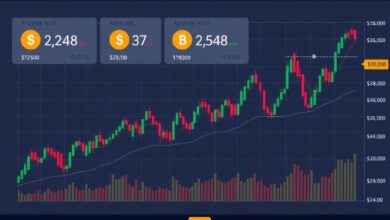How to trade on DEX platforms – Uniswap & PancakeSwap

Utilizing liquidity pools effectively is key to optimizing swaps on decentralized exchanges. Focus on identifying high-volume trading pairs that exhibit consistent price movement. By analyzing historical data, you can pinpoint the most favorable entry and exit points for your crypto transactions.
Token selection plays a crucial role in profitability. Prioritize pairs with low slippage and higher liquidity to minimize transaction costs. This will allow for smoother exchanges and reduce the chances of adverse price changes during your trades.
Engaging with community insights can also enhance decision-making. Platforms like Discord or Telegram often host discussions about emerging tokens and market trends, providing valuable information for anticipating potential price shifts.
Implementing automated tools can streamline your activities. Consider using bots to execute trades based on specific criteria, allowing you to capitalize on opportunities even when you’re away from your screen.
Liquidity Pool Selection Tips
Select pools with high trading volume. High activity often leads to better price stability and reduced impermanent loss.
Analyze the token pairs carefully. Choose those with strong fundamentals or established market presence to minimize risks.
Inspect the pool’s liquidity depth. A deeper liquidity pool provides more efficient swaps, reducing slippage during transactions.
Monitor historical performance metrics. Look for pools that have consistently shown healthy returns over time.
Diversify across different assets. Don’t concentrate all funds in a single pool; spreading investments can mitigate potential losses.
Evaluate the fee structure of each pool. Higher fees may deter frequent trades but can enhance earnings from liquidity provision.
Stay informed about upcoming token launches or major events affecting specific tokens involved in your selected pools.
Consider community sentiment around token projects. Positive engagement can indicate potential growth and stability in the chosen pools.
Look into governance and protocol updates. Changes can impact liquidity dynamics and should influence your pool selection process.
Use analytical tools to track real-time data on price movements and volume changes across different decentralized exchanges for informed decisions.
Price Movement Analysis Techniques
Utilize candlestick patterns for understanding price movements of tokens on decentralized exchanges. Patterns such as doji, engulfing, and hammers provide insights into market sentiment, indicating potential reversals or continuations in price trends.
Incorporate volume analysis alongside price changes. High trading volume during a price increase signals strong buying interest, while low volume can indicate weak momentum. Monitor the volume spikes to identify key support and resistance levels within your crypto portfolio.
Apply moving averages, specifically the 50-day and 200-day simple moving averages (SMA). Crossovers between these lines often signal significant shifts in market direction. A bullish crossover occurs when the short-term SMA crosses above the long-term SMA, suggesting upward price movement.
Leverage Relative Strength Index (RSI) to assess overbought or oversold conditions. An RSI above 70 may signal that a token is overvalued and due for a correction, while an RSI below 30 indicates it might be undervalued with potential for upward movement.
Explore Fibonacci retracement levels. These levels help identify possible reversal points by marking potential support and resistance zones based on the token’s previous price movements. Traders can set buy orders around these critical levels during periods of consolidation.
Monitor news and social media sentiment. Events affecting specific cryptocurrencies can lead to sharp price fluctuations. Use tools like sentiment analysis platforms to gauge public perception before executing swaps on different tokens.
Consider order book dynamics. Analyze the depth of the order book on exchanges; large buy walls can indicate potential support, while significant sell walls may suggest resistance areas. This information helps anticipate market movements before they occur.
Arbitrage Opportunities Explored
Monitor price discrepancies across multiple platforms. Implement automated scripts to execute trades swiftly when a favorable difference appears between assets on various decentralized exchanges. For instance, if a token is priced lower on one exchange than another, purchase it where it’s cheaper and sell it at a premium elsewhere.
Focus on liquidity pools with high trading volumes. These often exhibit more stable prices, reducing the likelihood of slippage and enhancing profit margins during arbitrage transactions. Analyze historical data for specific tokens to identify patterns that might signal potential future opportunities.
Utilize tools that track real-time price movements. Platforms like DEX aggregators can help pinpoint the most lucrative arbitrage opportunities by comparing rates across different exchanges instantly. This ensures that you capitalize on minor fluctuations before they vanish.
Consider transaction fees carefully; they can erode profits in arbitrage operations. Choose networks with lower fees or select tokens with higher values to ensure that costs do not outweigh gains achieved through these trades.
Engage in cross-chain arbitrage as well. Different blockchains may list the same asset at varying prices due to market inefficiencies. Utilize bridges or swap protocols to move tokens between chains seamlessly while capturing price differences.
Keep an eye on gas fees, especially during network congestion periods, as they can significantly impact your bottom line. Timing your trades when network traffic is low can enhance profitability.
Lastly, stay informed about regulatory developments affecting crypto markets, as changes can influence asset prices quickly, creating unexpected arbitrage situations ripe for exploitation.
Impermanent Loss Mitigation Methods
Utilize stablecoin pairs in liquidity pools to minimize volatility impacts. These assets typically maintain a consistent price, reducing the risk of impermanent loss while providing yields through swaps.
- Dynamic Rebalancing: Regularly adjust your asset allocation based on market conditions. This involves shifting tokens in response to significant price movements, thereby limiting exposure to impermanent loss.
- Liquidity Mining Programs: Participate in incentive programs offered by platforms. Often, these initiatives provide additional tokens as rewards, which can offset potential losses from liquidity provision.
- Choosing Low Volatility Pairs: Select trading pairs with historically stable prices. Assets with lower volatility are less likely to experience drastic fluctuations that lead to impermanent loss.
- Time Your Entry and Exit: Monitor market trends and enter liquidity pools during periods of low volatility. Exiting at favorable times can help secure profits before significant price changes occur.
Employing these methods enhances resilience against market shifts and optimizes returns within decentralized exchanges. Assess each option carefully based on your risk tolerance and market outlook.
- Evaluate current market conditions before making decisions.
- Diversify across multiple pools to spread risk effectively.
- Stay informed about the assets you are pooling; understanding their fundamentals can guide better choices.
A proactive approach is key to managing risks associated with impermanent loss while maximizing potential rewards through token swaps in liquidity provisioning environments.
Token Pairing Best Practices
Select pairs with complementary market behaviors. For instance, combining a stablecoin with a volatile asset often reduces risk while maximizing potential rewards from price swings.
Prioritize liquidity when choosing pairs. High liquidity ensures better price execution and minimizes slippage during swaps, enhancing overall trading efficiency.
Analyze correlation between selected tokens. Pairs that exhibit low correlation can mitigate the impact of adverse price movements, offering a buffer against volatility in one token affecting another.
Review historical performance metrics. Utilize past data to assess how well pairs have performed during different market conditions, identifying trends that may repeat in the future.
Consider community sentiment around each token. Active communities can drive interest and demand, influencing price movements positively for both assets within the pair.
Utilize decentralized tools for real-time analytics on token performance and trading volume. Staying informed on these metrics aids in making timely decisions regarding pair selections.
Evaluate the underlying technology of each token. Projects with robust fundamentals tend to withstand market fluctuations better than those lacking solid backing.
Adjust pairings based on evolving market conditions. Flexibility allows for capitalizing on new opportunities or avoiding potential downturns by reassessing existing combinations regularly.







